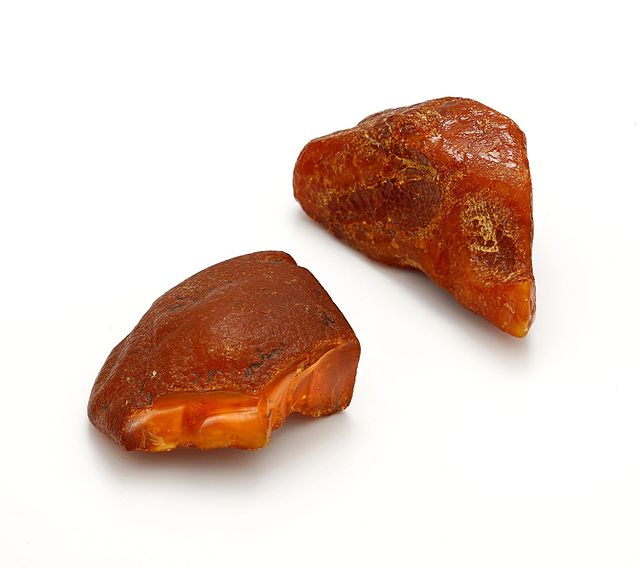Loading AI tools
The Prussian Formation, previously known as the Amber Formation, is a geologic formation in Prussia, today mostly Kaliningrad Oblast that dates to the Eocene.[1] It holds 90% of the world's amber supply and Baltic amber is found exclusively in the Prussian Formation.[2]
| Prussian Formation | |
|---|---|
| Stratigraphic range: Eocene, | |
 | |
| Type | Geological formation |
| Sub-units |
|
| Lithology | |
| Other | Phosphorite, Amber, Glauconite |
| Location | |
| Location | Kaliningrad Oblast, Russia |
| Type section | |
| Region | Sambian Peninsula |
The Prussian Formation is equivalent to the Obukhov Formation of Ukraine and Belarus.

In situ Baltic amber is found within the Prussian Formation, with the main amber bearing horizon being referred to as "Blue Earth", so named due to its glauconite content. The formation is exposed in the northern part of the Sambia Peninsula in Kaliningrad.
Different authors have given estimates of 40-47 million years ago and 35-43 million years ago as the age of the Prussian Formation.[1]
Numerous extinct genera and species of plants and animals have been discovered and scientifically described from inclusions in the Prussian Formation.[3] Inclusions of insects make up over 98% of the animals preserved in the amber, while all other arthropods, annelids, molluscs, nematodes, protozoans contribute less than 0.5% of the animals. Vertebrates are another 0.5% of the animals included and mostly are represented by mammal fur, feathers, and reptiles.[4]
Flora
| Name | Authors | Year | Family | Notes | Images |
|---|---|---|---|---|---|
| Heinrichs et al | 2015 | Geocalycaceae | A liverwort | ||
| Heinrichs et al | 2014 | Mniaceae | A bryopsid moss | ||
Fauna
- Agroecomyrmex Wheeler, 1910[7]
- Aphaenogaster mersa Wheeler, 1915[7]
- Aphaenogaster oligocenica Wheeler, 1915[7]
- Aphaenogaster sommerfeldti (Mayr, 1868)[7]
- Arostropsis Yunakov & Kirejtshuk, 2011[8]
- Aspidopleura Gibson, 2009[9]
- Asymphylomyrmex Wheeler, 1915[7]
- Balticopta gusakovi Balashov & Perkovsky, 2020[10]
- Baltimartyria Skalski, 1995
- Baltocteniza Eskov & Zonstein, 2000[11]
- Brevivulva Gibson, 2009[9]
- Deinodryinus areolatus (Ponomarenko, 1975)[12]
- Deinodryinus velteni Guglielmino & Olmi, 2011[12]
- Diochus electrus Chatzimanolis & Engel, 2011[13]
- Electrinocellia (Carpenter) Engel, 1995[14]
- Electrocteniza Eskov & Zonstein, 2000[11]
- Electropodagrion Azar & Nel, 2008[15]
- Electrostephanus Brues, 1933[16]
- Elektrithone Makarkin, Wedmann, & Weiterschan, 2014[17]
- Eogeometer vadens Fischer, Michalski & Hausmann, 2019[18]
- Epiborkhausenites Skalski, 1973[19]
- Glisachaemus Szwedo, 2007[20]
- Gracillariites Kozlov, 1987
- Metanephrocerus collini Carpenter & Hull, 1939[21]
- Metanephrocerus groehni Kehlmaier & Skevington, 2014[21]
- Metanephrocerus hoffeinsorum Kehlmaier & Skevington, 2014[21]
- Electrocrania Kuznezov, 1941
- Fibla carpenteri Engel, 1995[14]
- Metapelma archetypon Gibson, 2009[9]
- Micropterix gertraudae Kurz & Kurz, 2010
- Mindarus harringtoni (Hele, 2008)
- Neanaperiallus Gibson, 2009[9]
- Palaeovespa baltica Cockerell, 1909[22]
- Palaeovespa socialis Pionar, 2005[23]
- Prolyonetia Kusnetzov, 1941
- Propupa Stworzewicz & Pokryszko, 2006[24]
- Pseudogarypus synchrotron Henderickx, 2012[25]
- Stigmellites baltica (Kozlov, 1988) (Lepidopteran leaf mines)
- Xylolaemus sakhnovi Alekseev & Lord, 2014[26]
- Succinipatopsis Poinar, 2000[27]
- Yantarogekko balticus Bauer et al., 2005
- Yantaromyrmex constricta (Mayr, 1868)[28]
- Yantaromyrmex geinitzi (Mayr, 1868)[28]
- Yantaromyrmex samlandica (Wheeler, 1915)[28]
Wikiwand in your browser!
Seamless Wikipedia browsing. On steroids.
Every time you click a link to Wikipedia, Wiktionary or Wikiquote in your browser's search results, it will show the modern Wikiwand interface.
Wikiwand extension is a five stars, simple, with minimum permission required to keep your browsing private, safe and transparent.